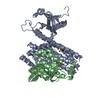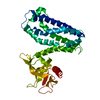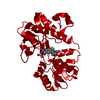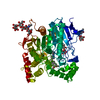[English] 日本語
 Yorodumi
Yorodumi- PDB-2nz8: N-terminal DHPH cassette of Trio in complex with nucleotide-free Rac1 -
+ Open data
Open data
- Basic information
Basic information
| Entry | Database: PDB / ID: 2nz8 | ||||||
|---|---|---|---|---|---|---|---|
| Title | N-terminal DHPH cassette of Trio in complex with nucleotide-free Rac1 | ||||||
 Components Components |
| ||||||
 Keywords Keywords |  SIGNALING PROTEIN / SIGNALING PROTEIN /  CELL CYCLE / Trio / CELL CYCLE / Trio /  Rac1 / Dbl-family GEF / Rho-family GTPase / DH/PH cassette Rac1 / Dbl-family GEF / Rho-family GTPase / DH/PH cassette | ||||||
| Function / homology |  Function and homology information Function and homology information cell surface receptor protein tyrosine phosphatase signaling pathway / cell surface receptor protein tyrosine phosphatase signaling pathway /  regulation of respiratory burst / negative regulation of interleukin-23 production / regulation of neutrophil migration / localization within membrane / Activated NTRK2 signals through CDK5 / regulation of respiratory burst / negative regulation of interleukin-23 production / regulation of neutrophil migration / localization within membrane / Activated NTRK2 signals through CDK5 /  NADPH oxidase complex / negative regulation of receptor-mediated endocytosis / regulation of hydrogen peroxide metabolic process / ruffle assembly ... NADPH oxidase complex / negative regulation of receptor-mediated endocytosis / regulation of hydrogen peroxide metabolic process / ruffle assembly ... cell surface receptor protein tyrosine phosphatase signaling pathway / cell surface receptor protein tyrosine phosphatase signaling pathway /  regulation of respiratory burst / negative regulation of interleukin-23 production / regulation of neutrophil migration / localization within membrane / Activated NTRK2 signals through CDK5 / regulation of respiratory burst / negative regulation of interleukin-23 production / regulation of neutrophil migration / localization within membrane / Activated NTRK2 signals through CDK5 /  NADPH oxidase complex / negative regulation of receptor-mediated endocytosis / regulation of hydrogen peroxide metabolic process / ruffle assembly / NTRK2 activates RAC1 / engulfment of apoptotic cell / Inactivation of CDC42 and RAC1 / WNT5:FZD7-mediated leishmania damping / SEMA3A-Plexin repulsion signaling by inhibiting Integrin adhesion / cortical cytoskeleton organization / NADPH oxidase complex / negative regulation of receptor-mediated endocytosis / regulation of hydrogen peroxide metabolic process / ruffle assembly / NTRK2 activates RAC1 / engulfment of apoptotic cell / Inactivation of CDC42 and RAC1 / WNT5:FZD7-mediated leishmania damping / SEMA3A-Plexin repulsion signaling by inhibiting Integrin adhesion / cortical cytoskeleton organization /  respiratory burst / hepatocyte growth factor receptor signaling pathway / ruffle organization / cell projection assembly / respiratory burst / hepatocyte growth factor receptor signaling pathway / ruffle organization / cell projection assembly /  thioesterase binding / negative regulation of fibroblast migration / thioesterase binding / negative regulation of fibroblast migration /  regulation of stress fiber assembly / RHO GTPases activate CIT / Nef and signal transduction / sphingosine-1-phosphate receptor signaling pathway / PCP/CE pathway / motor neuron axon guidance / RHO GTPases activate KTN1 / regulation of nitric oxide biosynthetic process / regulation of stress fiber assembly / RHO GTPases activate CIT / Nef and signal transduction / sphingosine-1-phosphate receptor signaling pathway / PCP/CE pathway / motor neuron axon guidance / RHO GTPases activate KTN1 / regulation of nitric oxide biosynthetic process /  regulation of lamellipodium assembly / positive regulation of neutrophil chemotaxis / Azathioprine ADME / Activation of RAC1 / DCC mediated attractive signaling / positive regulation of cell-substrate adhesion / MET activates RAP1 and RAC1 / regulation of lamellipodium assembly / positive regulation of neutrophil chemotaxis / Azathioprine ADME / Activation of RAC1 / DCC mediated attractive signaling / positive regulation of cell-substrate adhesion / MET activates RAP1 and RAC1 /  Wnt signaling pathway, planar cell polarity pathway / regulation of small GTPase mediated signal transduction / Sema4D mediated inhibition of cell attachment and migration / CD28 dependent Vav1 pathway / Ephrin signaling / Wnt signaling pathway, planar cell polarity pathway / regulation of small GTPase mediated signal transduction / Sema4D mediated inhibition of cell attachment and migration / CD28 dependent Vav1 pathway / Ephrin signaling /  lamellipodium assembly / positive regulation of Rho protein signal transduction / negative regulation of fat cell differentiation / establishment or maintenance of cell polarity / lamellipodium assembly / positive regulation of Rho protein signal transduction / negative regulation of fat cell differentiation / establishment or maintenance of cell polarity /  regulation of cell size / DSCAM interactions / regulation of cell size / DSCAM interactions /  extrinsic component of membrane / Activation of RAC1 downstream of NMDARs / Rho GDP-dissociation inhibitor binding / small GTPase-mediated signal transduction / postsynaptic modulation of chemical synaptic transmission / presynaptic active zone / NRAGE signals death through JNK / Rac protein signal transduction / RHOJ GTPase cycle / RHO GTPases activate PAKs / positive regulation of focal adhesion assembly / semaphorin-plexin signaling pathway / CDC42 GTPase cycle / ficolin-1-rich granule membrane / Sema3A PAK dependent Axon repulsion / RHOG GTPase cycle / EPH-ephrin mediated repulsion of cells / RHO GTPases Activate NADPH Oxidases / RHOA GTPase cycle / RHO GTPases Activate WASPs and WAVEs / anatomical structure morphogenesis / RAC3 GTPase cycle / RAC2 GTPase cycle / RHO GTPases activate IQGAPs / localization / PTK6 Regulates RHO GTPases, RAS GTPase and MAP kinases / positive regulation of lamellipodium assembly / positive regulation of substrate adhesion-dependent cell spreading / extrinsic component of membrane / Activation of RAC1 downstream of NMDARs / Rho GDP-dissociation inhibitor binding / small GTPase-mediated signal transduction / postsynaptic modulation of chemical synaptic transmission / presynaptic active zone / NRAGE signals death through JNK / Rac protein signal transduction / RHOJ GTPase cycle / RHO GTPases activate PAKs / positive regulation of focal adhesion assembly / semaphorin-plexin signaling pathway / CDC42 GTPase cycle / ficolin-1-rich granule membrane / Sema3A PAK dependent Axon repulsion / RHOG GTPase cycle / EPH-ephrin mediated repulsion of cells / RHO GTPases Activate NADPH Oxidases / RHOA GTPase cycle / RHO GTPases Activate WASPs and WAVEs / anatomical structure morphogenesis / RAC3 GTPase cycle / RAC2 GTPase cycle / RHO GTPases activate IQGAPs / localization / PTK6 Regulates RHO GTPases, RAS GTPase and MAP kinases / positive regulation of lamellipodium assembly / positive regulation of substrate adhesion-dependent cell spreading /  regulation of cell migration / positive regulation of microtubule polymerization / RHO GTPases activate PKNs / positive regulation of stress fiber assembly / GPVI-mediated activation cascade / RAC1 GTPase cycle / EPHB-mediated forward signaling / actin filament polymerization / cell chemotaxis / substrate adhesion-dependent cell spreading / guanyl-nucleotide exchange factor activity / cell-matrix adhesion / regulation of cell migration / positive regulation of microtubule polymerization / RHO GTPases activate PKNs / positive regulation of stress fiber assembly / GPVI-mediated activation cascade / RAC1 GTPase cycle / EPHB-mediated forward signaling / actin filament polymerization / cell chemotaxis / substrate adhesion-dependent cell spreading / guanyl-nucleotide exchange factor activity / cell-matrix adhesion /  small monomeric GTPase / neuron projection morphogenesis / G protein activity / positive regulation of endothelial cell migration / secretory granule membrane / VEGFR2 mediated vascular permeability / Signal transduction by L1 / cell projection / actin filament organization / small monomeric GTPase / neuron projection morphogenesis / G protein activity / positive regulation of endothelial cell migration / secretory granule membrane / VEGFR2 mediated vascular permeability / Signal transduction by L1 / cell projection / actin filament organization /  cell motility / RHO GTPases Activate Formins / Translocation of SLC2A4 (GLUT4) to the plasma membrane cell motility / RHO GTPases Activate Formins / Translocation of SLC2A4 (GLUT4) to the plasma membraneSimilarity search - Function | ||||||
| Biological species |   Homo sapiens (human) Homo sapiens (human) | ||||||
| Method |  X-RAY DIFFRACTION / X-RAY DIFFRACTION /  SYNCHROTRON / SYNCHROTRON /  MOLECULAR REPLACEMENT / Resolution: 2 Å MOLECULAR REPLACEMENT / Resolution: 2 Å | ||||||
 Authors Authors | Chhatriwala, M.K. / Betts, L. / Worthylake, D.K. / Sondek, J. | ||||||
 Citation Citation |  Journal: J.Mol.Biol. / Year: 2007 Journal: J.Mol.Biol. / Year: 2007Title: The DH and PH Domains of Trio Coordinately Engage Rho GTPases for their Efficient Activation Authors: Chhatriwala, M.K. / Betts, L. / Worthylake, D.K. / Sondek, J. | ||||||
| History |
|
- Structure visualization
Structure visualization
| Structure viewer | Molecule:  Molmil Molmil Jmol/JSmol Jmol/JSmol |
|---|
- Downloads & links
Downloads & links
- Download
Download
| PDBx/mmCIF format |  2nz8.cif.gz 2nz8.cif.gz | 210.9 KB | Display |  PDBx/mmCIF format PDBx/mmCIF format |
|---|---|---|---|---|
| PDB format |  pdb2nz8.ent.gz pdb2nz8.ent.gz | 168.5 KB | Display |  PDB format PDB format |
| PDBx/mmJSON format |  2nz8.json.gz 2nz8.json.gz | Tree view |  PDBx/mmJSON format PDBx/mmJSON format | |
| Others |  Other downloads Other downloads |
-Validation report
| Arichive directory |  https://data.pdbj.org/pub/pdb/validation_reports/nz/2nz8 https://data.pdbj.org/pub/pdb/validation_reports/nz/2nz8 ftp://data.pdbj.org/pub/pdb/validation_reports/nz/2nz8 ftp://data.pdbj.org/pub/pdb/validation_reports/nz/2nz8 | HTTPS FTP |
|---|
-Related structure data
- Links
Links
- Assembly
Assembly
| Deposited unit | 
| |||||||||
|---|---|---|---|---|---|---|---|---|---|---|
| 1 |
| |||||||||
| Unit cell |
| |||||||||
| Components on special symmetry positions |
| |||||||||
| Details | There is one biological unit in each assymetric unit (complex between Rac1 and Trio DH/PH) |
- Components
Components
| #1: Protein | Mass: 19710.764 Da / Num. of mol.: 1 / Fragment: soluble part (residues 1-177) Source method: isolated from a genetically manipulated source Source: (gene. exp.)   Homo sapiens (human) / Gene: RAC1 / Plasmid: pET15b / Species (production host): Escherichia coli / Production host: Homo sapiens (human) / Gene: RAC1 / Plasmid: pET15b / Species (production host): Escherichia coli / Production host:   Escherichia coli BL21(DE3) (bacteria) / Strain (production host): BL21 (DE3) / References: UniProt: P63000 Escherichia coli BL21(DE3) (bacteria) / Strain (production host): BL21 (DE3) / References: UniProt: P63000 |
|---|---|
| #2: Protein | Mass: 36561.953 Da / Num. of mol.: 1 / Fragment: N-terminal DH/PH cassette (residues 1226-1535) Source method: isolated from a genetically manipulated source Source: (gene. exp.)   Homo sapiens (human) / Gene: TRIO / Plasmid: pPROEX-HTa / Species (production host): Escherichia coli / Production host: Homo sapiens (human) / Gene: TRIO / Plasmid: pPROEX-HTa / Species (production host): Escherichia coli / Production host:   Escherichia coli BL21(DE3) (bacteria) / Strain (production host): BL21 (DE3) / References: UniProt: O75962 Escherichia coli BL21(DE3) (bacteria) / Strain (production host): BL21 (DE3) / References: UniProt: O75962 |
| #3: Water | ChemComp-HOH /  Water Water |
-Experimental details
-Experiment
| Experiment | Method:  X-RAY DIFFRACTION / Number of used crystals: 1 X-RAY DIFFRACTION / Number of used crystals: 1 |
|---|
- Sample preparation
Sample preparation
| Crystal | Density Matthews: 2.51 Å3/Da / Density % sol: 51.01 % |
|---|---|
Crystal grow | Temperature: 291 K / Method: vapor diffusion / pH: 6 Details: 100 mM sodium cacodylate pH 5.5 to 6.5, 14 to 18% (w/v) PEG 8000, and 300-500 mM calcium acetate, pH 6.0, VAPOR DIFFUSION, temperature 291K |
-Data collection
| Diffraction | Mean temperature: 100 K |
|---|---|
| Diffraction source | Source:  SYNCHROTRON / Site: SYNCHROTRON / Site:  APS APS  / Beamline: 22-ID / Wavelength: 1.0712 Å / Beamline: 22-ID / Wavelength: 1.0712 Å |
| Detector | Type: MARMOSAIC 300 mm CCD / Detector: CCD / Date: Oct 29, 2004 |
| Radiation | Monochromator: double crystal Si (220) cryogenically cooled monochromator Protocol: SINGLE WAVELENGTH / Monochromatic (M) / Laue (L): M / Scattering type: x-ray |
| Radiation wavelength | Wavelength : 1.0712 Å / Relative weight: 1 : 1.0712 Å / Relative weight: 1 |
| Reflection | Resolution: 2→20 Å / Num. all: 39574 / Num. obs: 39416 / % possible obs: 99.6 % / Observed criterion σ(I): -3 / Redundancy: 5.4 % / Rsym value: 0.069 / Χ2: 1.824 / Net I/σ(I): 15.6 |
| Reflection shell | Resolution: 2→2.07 Å / Redundancy: 4.2 % / Mean I/σ(I) obs: 3.53 / Num. unique all: 3903 / Rsym value: 0.524 / Χ2: 1.124 / % possible all: 99.8 |
-Phasing
| Phasing MR |
|
|---|
- Processing
Processing
| Software |
| |||||||||||||||||||||||||||||||||||||||||||||||||||||||||||||||||||||||||||||||||||||||||||||||||||||||||||||||||||||||||||||
|---|---|---|---|---|---|---|---|---|---|---|---|---|---|---|---|---|---|---|---|---|---|---|---|---|---|---|---|---|---|---|---|---|---|---|---|---|---|---|---|---|---|---|---|---|---|---|---|---|---|---|---|---|---|---|---|---|---|---|---|---|---|---|---|---|---|---|---|---|---|---|---|---|---|---|---|---|---|---|---|---|---|---|---|---|---|---|---|---|---|---|---|---|---|---|---|---|---|---|---|---|---|---|---|---|---|---|---|---|---|---|---|---|---|---|---|---|---|---|---|---|---|---|---|---|---|---|
| Refinement | Method to determine structure : :  MOLECULAR REPLACEMENT MOLECULAR REPLACEMENTStarting model: residues 1231-1390 of PDB entry 1NTY and residues 1-177 of PDB entry 1FOE Resolution: 2→19.41 Å / Cor.coef. Fo:Fc: 0.939 / Cor.coef. Fo:Fc free: 0.917 / SU B: 8.565 / SU ML: 0.111 / Isotropic thermal model: isotropic / Cross valid method: THROUGHOUT / σ(F): 0 / ESU R: 0.195 / ESU R Free: 0.165 / Stereochemistry target values: MAXIMUM LIKELIHOOD / Details: HYDROGENS HAVE BEEN ADDED IN THE RIDING POSITIONS
| |||||||||||||||||||||||||||||||||||||||||||||||||||||||||||||||||||||||||||||||||||||||||||||||||||||||||||||||||||||||||||||
| Solvent computation | Ion probe radii: 0.8 Å / Shrinkage radii: 0.8 Å / VDW probe radii: 1.2 Å / Solvent model: MASK | |||||||||||||||||||||||||||||||||||||||||||||||||||||||||||||||||||||||||||||||||||||||||||||||||||||||||||||||||||||||||||||
| Displacement parameters | Biso mean: 41.241 Å2
| |||||||||||||||||||||||||||||||||||||||||||||||||||||||||||||||||||||||||||||||||||||||||||||||||||||||||||||||||||||||||||||
| Refinement step | Cycle: LAST / Resolution: 2→19.41 Å
| |||||||||||||||||||||||||||||||||||||||||||||||||||||||||||||||||||||||||||||||||||||||||||||||||||||||||||||||||||||||||||||
| Refine LS restraints |
| |||||||||||||||||||||||||||||||||||||||||||||||||||||||||||||||||||||||||||||||||||||||||||||||||||||||||||||||||||||||||||||
| LS refinement shell | Resolution: 2→2.051 Å / Total num. of bins used: 20
| |||||||||||||||||||||||||||||||||||||||||||||||||||||||||||||||||||||||||||||||||||||||||||||||||||||||||||||||||||||||||||||
| Refinement TLS params. | Method: refined / Refine-ID: X-RAY DIFFRACTION
| |||||||||||||||||||||||||||||||||||||||||||||||||||||||||||||||||||||||||||||||||||||||||||||||||||||||||||||||||||||||||||||
| Refinement TLS group | Refine-ID: X-RAY DIFFRACTION / Selection: ALL
|
 Movie
Movie Controller
Controller














 PDBj
PDBj



















